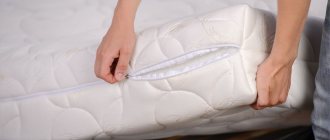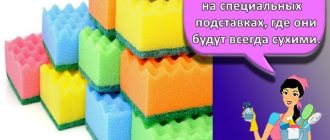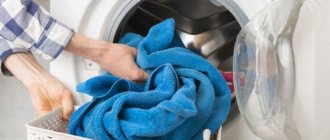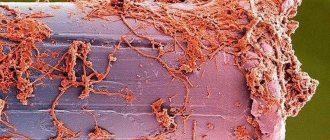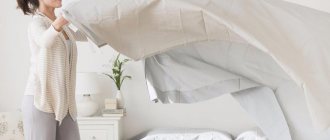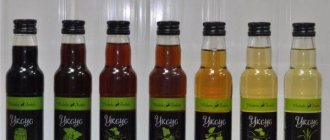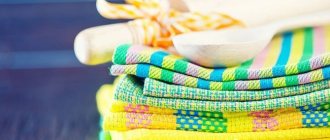It's no secret that kitchen rags and sponges are one of the dirtiest items in the house; in terms of the degree of contamination with microbes, they easily surpass even toilet rims. However, not all housewives agree to poison themselves and loved ones with bleach, so they successfully use other, less allergenic methods of disinfection. With their help, you can significantly extend the life of towels, rags and sponges, and therefore save on their purchase.
Soaking with vinegar
To ensure that the rag always smells nice and looks neat, it is recommended to sometimes soak it in 5% vinegar. You can buy such a ready-made solution or prepare it yourself from 70% essence. It is enough to hold the fabric in it for about 10 minutes and then rinse.
This treatment will protect the fibers from mold that may occur due to dampness. You should not keep kitchen utensils in the solution for too long, since acetic acid affects the strength of the material.
Boiling
Boiling is a proven “grandmother’s” method for returning a pleasant aroma to kitchen towels. Before boiling, you should separate the products into colored and white to avoid molting of flowers.
You can simply boil the towels for about 1 hour in a saucepan, then put them in the washing machine and wash them again at a temperature of 60-90⁰C without adding any products. But after treatment with boiling water alone, the product will become more rigid compared to its original state.
To avoid this, there is another option: boiling. A large 12-15 liter saucepan is filled halfway with cold water. Then you need to add the following components:
- half a glass of soda;
- four tablespoons of hydrogen peroxide;
- any oxygen stain remover;
- half a piece of laundry soap 72%, grated on a coarse grater.
Mix everything thoroughly and put towels in the pan. Then add more cold water, not reaching the edge of the container by 5-6 cm. Put everything on the fire and wait for the water to boil.
After the water boils, simmer for at least 45 minutes. Remove the boiled products from the pan and place them in the washing machine. Add table vinegar and water in equal parts to the air conditioner compartment. Wash on boiling cycle. After this treatment, the laundry will be soft and fluffy.
Thus, with the right choice of method for washing kitchen towels, the problem of unpleasant odor can be easily dealt with.
I came up with a simple but effective way to prevent kitchen rags from smelling. I share with you
Hi all! Today I will show you how to easily get rid of the unpleasant smell of a dishcloth without long soaking, boiling and the use of dangerous chemicals.
Sooner or later, kitchen rags begin to emit an unpleasant musty smell. This occurs as a result of the activity of bacteria formed from the remains of fat, food and dampness.
During normal washing, bacteria remain inside the rag. Thus, at the first contact with biological products and water, they begin to actively multiply again, emitting a foul aroma.
But if it’s easier to throw away a sponge for washing dishes and replace it with a new one, then throwing away a kitchen cloth every time it smells is very uneconomical.
To get rid of this unpleasant odor, it is not necessary to resort to special disinfectants containing chlorine-containing substances that are hazardous to health.
I've come up with a clever way to help give new life to your dishcloths! I do this:
I generously wet a kitchen cloth. I apply dishwashing detergent. Wrinkle until foam appears.
Next, I put the cloth on a plate and put it in the microwave for 2 minutes, at maximum power.
Once the 2 minutes are up, I take out a plate with a cloth and let it cool a little. Next you need to rinse it properly. And dry it.
By heating a wet cloth in a microwave oven, we sterilize it with steam, thereby killing bacteria. After the cloth dried, not a trace remained of the smell.
I carry out this procedure as soon as I feel a slight smell again. Now you know how to deal with it!
Source
Thorough rinsing and drying
In order to initially prevent the appearance of an unpleasant odor, do not forget that after washing dishes or cleaning the kitchen, the cloth also needs to be washed. The fibers of the fabric and the pores of the sponge accumulate fat, household chemicals, crumbs and other food residues, which, in turn, are the reason for the appearance of a characteristic amber in kitchen assistants. But rags that are thoroughly washed and dried after use do not smell.
Where does it come from?
The cause of the stench can be different; just leave a damp towel after a shower, and mold will appear on it after a while.
Wet things are a breeding ground for bacteria. If you do not dry them in time, an unpleasant stench will appear, which appears due to the rapid proliferation of harmful microorganisms that poison the lives of household members.
Why does a towel smell bad?
- the washing machine does not wipe dry, bacteria collect and multiply in places that are difficult for a woman to reach, mold forms and spreads to things;
- long-term use of towels;
- increased humidity in the place where things dry;
- the wrong washing mode is set;
- the towel is not completely dry;
- poor quality material.
If your towels stink after washing, you should first eliminate all these factors. Even one of them can cause a stench, after which terry or other textile material cannot be reused.
Every housewife should know how to wash towels if an unpleasant odor appears. Eliminating the problem is possible using folk methods or purchased products.
Basic methods of struggle
Before you begin to solve the problem described, it is necessary to normalize the microclimate in the room where towels are stored. To do this, you need to ventilate the room and check the operation of the ventilation. You should also hang the towel on the dryer or in fresh air. Often these manipulations are enough to get rid of the unpleasant odor.
Boiling
If the towel smells bad, this product can be washed in boiling water. This procedure is recommended to be carried out in compliance with the following rules:
- You can boil fabric products.
- To carry out the procedure, you should use a washing machine, setting the maximum temperature and the timer for 2 hours.
- After treatment, the product can be soaked in conditioner, since prolonged exposure to elevated temperatures makes the towel hard.
You can also boil colored towels. If the described recommendations are not followed, the product will lose its original appearance.
- How to quickly fold a T-shirt: men's, women's and children's
Washing with vinegar and soda
If the towel smells bad, you can use the following method:
- Pour a tablespoon of soda into the machine along with the washing powder.
- Wash the product at medium temperature.
- While rinsing, add a tablespoon of vinegar.
If after washing there is a noticeable smell of vinegar, then you need to rinse the towel again in clean water.
Proper drying
Towels must be dried in ventilated areas (with good ventilation) or in the fresh air. Otherwise, the material will begin to emit an unpleasant odor within one day after hanging. It is recommended to dry the products on a heated towel rail or radiator.
Soak
By soaking, you can also get rid of persistent odors. Regardless of the chosen means, the procedure itself is carried out according to the following algorithm:
- An unpleasant-smelling product is pre-soaked in clean water.
- Powder and the selected cleaning product are poured into the washing machine.
- The maximum temperature is set and the wash starts.
If necessary, you can soak contaminated textiles for 15 minutes in a basin with bleach diluted in water.
Bleaching
Bleach is used to remove particularly pungent odors. This product is also suitable for cleaning mold. Bleach should not be used often. This substance can corrode fabric. After treatment with bleach, the product must be rinsed in clean water.
"White"
“Whiteness,” like bleach, copes well with persistent odors. This product can also be used as a bleach to remove difficult stains. But before the first use, it is necessary to clarify whether “Whiteness” can be used to clean a specific towel (this is indicated on the label).
"Toilet duckling"
“Toilet duck” can also remove unpleasant odors. This tool is used according to the described algorithm. But, as in previous cases, it is impossible to use “Toilet Duckling” often, since this product contains aggressive substances.
- How to remove tar from clothes at home: the best remedies, step-by-step instructions
Bleach or Lye
To get rid of the stench of bath accessories, you need to fill the container one third with wood ash and fill it with water. After this, the material should be left for 2-3 days. After the specified period has expired, the solution is drained through gauze.
The remainder in the container can later be used to refresh towels. This alkali or bleach must be diluted in water. Then you should soak the smelling towel in the resulting solution for several hours. After this, the product must be rinsed and hung to dry.
It is prohibited to use the described detergents in a machine.
Increasing the washing dose
Often, to remove an unpleasant odor, it is enough to re-wash the textiles in the machine, doubling the volume of powder used. It is recommended to do this without adding conditioner.
Special means
Due to the fact that some traditional methods can damage the fabric, you can use specialized products to remove the foul odor. However, even in this case, it is necessary to follow the manufacturer’s recommendations indicated on the label.
Top Hygia
Pros and cons convenient form of release (a container with a dispenser); cleans bacteria; consumes little; eliminates unpleasant odors in one use; suitable for any type of washing and laundry. The product is difficult to find; may cause allergies; overpriced (a bottle with a capacity of 400 milliliters costs about 300 rubles).
The rules and scope of use of Top Hygia are indicated on the packaging.
Oxiclean
Despite the effectiveness of this product in the fight against unpleasant “odors,” people buy Oxiclean relatively rarely.
Pros and cons Available in a convenient form (gel, granular powder and capsules); suitable for various materials; eliminates unpleasant odors and removes old stains. The product is suitable for cleaning only white fabrics; cannot be used for hand washing; costs more than 600 rubles per package.
In addition, Oxiclean, unlike Top Hygia, cannot be used to clean moldy towels.
Microwave
This method allows you to quickly get rid of unpleasant odor. To do this, just place the towel in the microwave for 30 seconds, and then wash it with regular powder.
Bringing back freshness: what to do if towels smell unpleasant after washing?
Many housewives often wonder why only washed towels do not smell fresh at all.
In fact, this phenomenon is not uncommon, since towels are a real breeding ground for bacteria. This is due to the fact that kitchen towels strongly absorb food odors, and bath towels absorb moisture.
To avoid this problem, you should approach the washing and drying process correctly, and also listen to a number of useful recommendations. This will be discussed in the article.
Washing kitchen towels by hand
During washing, you need to perform a number of actions:
- Take a basin where dirty things are placed;
- Boiled water is poured, powder is added;
- To soften the water, add two glasses of vinegar;
- Things are soaked for 30 minutes;
- Towels are pulled out and rinsed;
- Dirty water is poured out of the basin and new water is poured into which one spoon of salt is added;
- The towels are rinsed in the resulting solution;
- Things are removed and wrung out, after which they are hung to dry.
In addition, before washing, they can be soaked in another solution, which consists of one liter of hot water, 1 tablespoon of salt and powder. During the soaking process, areas where there are persistent stains must be thoroughly washed.
Warming up in the microwave
The last method is express disinfection in 2 minutes. A dishcloth should be thoroughly moistened with water and soaped with dishwashing detergent, but not rinsed, but placed on a plate and placed in the microwave for 2 minutes. Then let the cloth cool slightly and rinse thoroughly under running water, then dry. Warming up in the microwave as a method of disinfection is also suitable for a kitchen sponge.
Important: only well-moistened rags and sponges can be disinfected in the microwave. Dry ones can catch fire when exposed to microwave radiation. For the same reason, you should not increase the processing time, the liquid may evaporate, and the fabric or sponge may ignite.
Getting rid of the musty smell of kitchen towels can be very difficult. But this problem can be solved. Let's try to figure out how to remove the smell from kitchen towels so that they remain fresh and clean.

